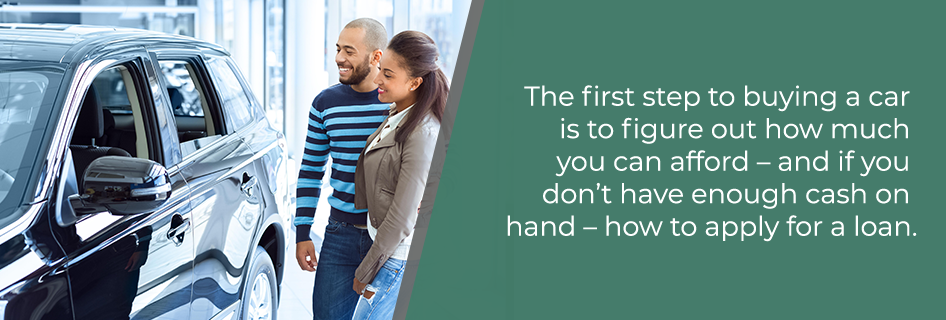In the market for a new set of wheels? Whether you’re looking to buy your first car or upgrade to one that fits your current lifestyle, the internet makes it easier than ever to shop smart and drive in style. (Heck, you can even get cars delivered to you like pizza!)
But first, you’ll need to figure out what you can afford and — if you don’t have enough cash on hand — how to apply for a car loan. Don’t worry, we’ve got you covered.

The Big Decision: Choosing Between New and Used Cars
No matter whether you’re looking for a sports car, pickup truck, motorcycle, or minivan, here’s the main thing to remember — vehicles are depreciating assets. So, don’t think of yours as one that’s going to hold its value.
● New vehicles will never be worth as much as the day they come off the showroom floor. Once you pull off the lot, they can literally lose thousands of dollars in value. However, if you want new, consider buying “last year’s model”—when the 2021 vehicles are delivered, dealers don’t want a bunch of 2020 models clogging up the lot, and prices drop. Sites like Edmunds and Consumer Reports offer new car buying guides along with plenty of model reviews.
● Used vehicles have had a previous owner, and — here’s where you can benefit — someone else has already taken the biggest financial hit for you. Yes, used cars will lose value as well, but nowhere near as quickly as a new car during its first year on the road.
● No matter what type of car you’re interested in buying, start by searching sites like Cars.com, Carvana, and Truecar to narrow down your search (and shop by price). Then, visit multiple dealerships to test drive the vehicles you’re interested in — and explore sales and promotions each might have going on. Remember, dealers want your business, but what they really want is to keep you from buying a car at the dealer that’s 20 miles down the road.
Understanding Pre-Owned Vehicles: How Used is Really Used?
When looking at used vehicles, you’ll most certainly see the term preowned pop up more often than not. It’s a nicer-sounding way to say used—these terms are often used interchangeably.
However, there are different levels of used vehicles, so be sure to dive into the details so you’ll know
what you’re really getting:
- A used vehicle is simply one that’s been owned by someone else. Whether you’re purchasing from an auto dealer or a private party (another person), you’ll want to ask about things like repair records, maintenance history, and ownership history. You don’t have to take their answers for granted—ask the seller to provide you with a copy of the car’s vehicle history report from a reputable source like Carfax and Autocheck, which collect every piece of online data about the vehicle (from oil changes and accident reports to current title information) and present it to you in a simple, easy-to-understand format.
- Certified preowned cars are used as well, but in most cases, they’ve gone through an inspection and reconditioning process at a dealership. Because the dealer has inspected the car and made any necessary repairs in advance, its price will usually be higher than that of a comparable non-certified vehicle. However, a certified vehicle may also come with a warranty that will cover potential issues that arise over the next several years, giving you peace of mind at a relatively small price.
- Finally, let’s talk about lease returns. Leasing a new car is akin to renting one… as the borrower, you promise to pay a certain amount of money per month to drive a vehicle for, let’s say, two years. Since the dealer owns the car the entire time, they are very strict about mileage limits and damage to the vehicle while someone has it on-lease. Once the term of the lease expires, you can purchase the vehicle at a reduced rate or return it to the dealer and walk away. This is where you, as a used-car shopper, can get a great deal. Just like last year’s models, dealers don’t want two-year-old cars sitting on their lots, either. So, ask about lease returns or off-lease vehicles: in most cases, they’re in great shape and have relatively low mileage to accompany their lower price tags.

Navigating Auto Financing: What You Need to Know
Your next car is going to eat up a chunk of your monthly budget, so you’ll want to make sure you’ve run the numbers to make sure that you won’t be cash-poor (and “car-poor”) following your big purchase. When thinking about how much you want to buy and how much you want to spend, be sure to ponder how and when you’ll use your new vehicle.
Maybe you used to drive an hour each way to work, so you wanted your next ride to be big and comfy. However, thanks to COVID-19, you’re working at home and rarely leave the house these days. Don’t overspend your budget, and don’t buy a vehicle that doesn’t suit your needs.
Another thought: Even if you aren’t going to apply for a car loan, you’ll still need to have cash on hand to pay for all of your new car’s related charges (tax, title, and tag.) So, start saving today — if you don’t have the funds for a used or certified pre-owned car right away, you’ll have to make room in your budget to set money aside each month.
For the sake of this article, let’s say you’re going to need to get financing. Don’t ever, ever, ever go car shopping unless you get approved for a car loan first. That way, you’ll know exactly how much car you can afford and how much your monthly auto loan payments will be.
Almost every dealer you visit will offer you on-the-spot financing, which can take up a ton of your time if you’re just looking to buy. Having a preapproval in place allows you to compare any loan offers you receive and make sure you choose the one that’s right for you and your budget.

Here are a few basic things to look when reviewing vehicle loan offers:
- Principal: This is the amount of money you’ll borrow to buy a vehicle.
- Annual Percentage Rate (APR): How much extra money (shown as a percentage) you’ll pay to finance the vehicle.
- Term: The overall length of the loan (in months). When comparing loan offers, be sure that the term is the same for each — by lengthening the term (say, from 48 to 72 months, a dealership can make your estimated monthly payment appear much smaller… but you’ll pay a LOT more interest.
Smart Car Shopping: Essential Tips for Buyers
We want you to feel comfortable about your vehicle purchase—so be sure to follow these three tips to help you find the car that’s right for you today, tomorrow, and long down the road.
- Take it for a test drive. No matter what vehicle you’re planning to purchase, be sure to test-drive it before you buy it. Even if you agree to buy a vehicle online, you have the chance to inspect and drive the vehicle before the sale is complete. Don’t give that opportunity up.
- Have the vehicle inspected before purchase. Even if a certified preowned vehicle (or a new car, for that matter) comes with a warranty, you’ll want to make sure everything looks, sounds, and feels right before you sign on the dotted line. If a used vehicle dealer refuses to have the car inspected by a mechanic of your choice, it’s probably best to walk away.
- Know your worth. If you’re planning to trade in a vehicle that you’re currently driving, visit NADA.com, blackbook.com, or edmunds.com to estimate your car’s value. That way, you’ll know if a dealer’s trade-in offer is fair or not. Since dealers will lower their trade-in offers based on potential reconditioning or repair needs, you can also choose to sell your current vehicle online in a separate transaction.

Get Approved
Ready to get approved before you shop for a new vehicle? Apply for a car loan at Jefferson Security Bank today. If you’d like to learn more about our vehicle financing and personal loans, send us an email, visit one of our convenient locations, or give us a call at 304-876-9000.

